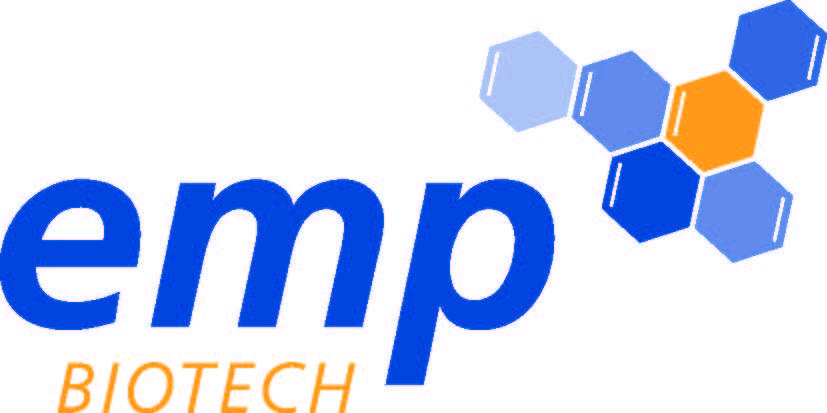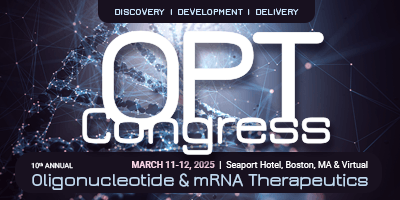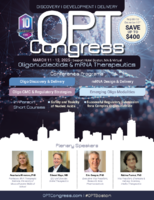Cambridge Healthtech Instituteの初開催
Emerging Oligonucleotide Modalities
オリゴヌクレオチドの新興モダリティ
Pursuing Circular RNA, tRNA, and Innovative Editing Approaches
環状RNA、tRNA、革新的な編集アプローチの追求
2025年3月11日 - 12日 EDT(米国東部標準時・夏時間)
3月11日(火)
8:00 amRecommended Short Course*
SC1: Safety & Toxicity of Nucleic Acids
*Premium Registration or separate registration required. See Short Courses page for details.
9:45 amRegistration and Morning Coffee
10:45 amWelcome Remarks by Conference Organizer
CIRCULAR RNA THERAPIES
環状RNA 療法
Circular RNA: Transforming a Promising Technology into Cutting-Edge Therapeutics
 Edo Kon, PhD, Director of Business Development, RiboX Therapeutics
Edo Kon, PhD, Director of Business Development, RiboX Therapeutics
RiboX Therapeutics is a globally-operated biotech company focusing on discovering and developing fully engineered circular RNA as a therapeutic modality, which offers advantages to address key challenges of mRNA medicines. RiboX has established a plug-and-play circular RNA platform, an ionizable lipid platform, and has unique assets in active targeting LNP under development.
Circular mRNA and Its Application in Immunotherapy and Genome Engineering
 Li Li, PhD, Assistant Professor, RNA Therapeutics Institute, University of Massachusetts Chan Medical School
Li Li, PhD, Assistant Professor, RNA Therapeutics Institute, University of Massachusetts Chan Medical School
Circular mRNA (CircRNA) has generated substantial interest as a new mRNA therapeutics platform. Here I will discuss a scalable and column-free method for preparing non-immunogenic circular mRNAs. I will also show its applications in immunotherapy and genome editing.
In vivo Cell Engineering Using oRNA
 Robert Mabry, PhD, CSO, Orna Therapeutics
Robert Mabry, PhD, CSO, Orna Therapeutics
In vivo CAR therapy could eliminate the need for patient cell isolation and avoid risks associated with conditioning regimens of CAR T therapies. Orna Therapeutic’s panCAR combines a synthetic, circular coding RNA platform (oRNA) and proprietary immunotropic lipid nanoparticle (LNP) to drive immune effector cell (e.g. T cells, NK cells) CAR expression after in vivo administration, promising a transient, re-dosable, and scalable immune cell therapy without preconditioning lymphodepletion.
12:30 pmTransition to Lunch
12:40 pmLuncheon Presentation (Sponsorship Opportunity Available) or Enjoy Lunch on Your Own
1:10 pmSession Break
DEVELOPING tRNA BASED THERAPIES
tRNA ベース療法の開発
Engineered Inhibitory tRNAs as Novel Therapeutics for Oncology
 Austin Draycott, PhD, CEO, Cloverleaf Bio
Austin Draycott, PhD, CEO, Cloverleaf Bio
At Cloverleaf Bio, we are developing a new class of engineered tRNA therapeutics. Our tRNAs target an underappreciated vulnerability of cancer: addiction to high levels of tRNA modifying enzymes. Cloverleaf’s approach to drugging tRNA modifying enzymes uses engineered “trojan horse” tRNAs. The programmability, potency, and specificity of our tRNAs will potentially improve cancer treatment across a range of indications.
FEATURED PRESENTATION: Design and Delivery of tRNA Therapeutics to Treat Stop Codon Disease
 William Kiesman, PhD, Chief Technology Officer, Alltrna
William Kiesman, PhD, Chief Technology Officer, Alltrna
This talk will explore designing, manufacturing, and delivering transfer RNA (tRNA) as a new therapeutic modality. We will examine how this innovative technology can be applied across diseases caused by a premature termination codon (PTC), collectively referred to as Stop Codon Disease, and discuss initial proof-of-concept experiments to unlock the potential in tRNA biology to create a universal precision medicine to treat diseases with shared genetic mutations.
2:55 pmSponsored Presentation (Opportunity Available)
3:25 pmGrand Opening Refreshment Break in the Exhibit Hall with Poster Viewing

PLENARY SESSION
プレナリーセッション
siRNA Chemical Engineering
 Anastasia Khvorova, PhD, Professor, RNA Therapeutic Institute, University of Massachusetts Medical School
Anastasia Khvorova, PhD, Professor, RNA Therapeutic Institute, University of Massachusetts Medical School
The focus of our lab is to identify, characterize, and develop novel chemistries that promote simple, efficient, and non-toxic delivery of oligonucleotides and potent silencing of therapeutic targets in vivo. Some examples will be highlighted in this talk.
TANGO: An RNA Splicing Approach to Upregulate Proteins
 Edward Kaye, MD, CEO and Director, Stoke Therapeutics
Edward Kaye, MD, CEO and Director, Stoke Therapeutics
Targeted Augmentation of Nuclear Gene Output (TANGO) is an RNA splicing approach that enables the upregulation of many proteins. Specifically designed Anti-sense Oligonucleotides (ASOs) splice out retained naturally occurring 'poison exons' or NMD exons from pre-mRNA, thus enabling an increase of full-length message and full-length protein. We are targeting autosomal dominant diseases which are missing 50% of an essential protein to correct the underlying genetic defect.
5:40 pm10th Annual Welcome Reception in the Exhibit Hall with Poster Viewing

6:50 pmClose of Day
3月12日(水)
7:30 amRegistration and Morning Coffee
NOVEL RNA THERAPIES FOR ONCOLOGY
オンコロジー向け新規RNA療法
RNA Activation in Cancer and Rare Genetic Diseases
 Nagy Habib, ChM, FRCS, Professor of Surgery, Imperial College London
Nagy Habib, ChM, FRCS, Professor of Surgery, Imperial College London
RNA activation with small activating RNAs can lead to upregulation of transcription in the nucleus resulting in increased mRNA and targeted protein. Such activation is specific and can last about a month This can be applied to many genes down regulated in common conditions such as cancer as well as rare genetic diseases such as sickle cell disease. Bio-distribution can be performed either with a universal or more targeted delivery approach. Wide bio-distribution is suitable in rare genetic diseases as well as with diseases related to the dark genome where the reduced long noncoding RNA is tissue, cell, and status specific.
KEYNOTE PRESENTATION: miRNA-Based Logic Circuits Encoded on Self-Amplifying RNA for Highly Specific Cancer Cell Classification
 Ron Weiss, PhD, Professor, Biological Engineering, Massachusetts Institute of Technology
Ron Weiss, PhD, Professor, Biological Engineering, Massachusetts Institute of Technology
We developed self-amplifying RNA and modified RNA platforms into vectors capable of carrying synthetic circuitry payloads that can provide a variety of desirable dynamics. We also encoded miRNA target sites on our RNA vectors to provide for highly specific cell type classification. We are using this technology to create next-generation cancer immunotherapy RNA vectors capable of activating therapeutic payloads discriminately in cancer cells.
9:05 amSponsored Presentation (Opportunity Available)
9:35 amCoffee Break in the Exhibit Hall with Poster Viewing

Advancing Cancer Immunotherapy with mRNA Synthetic Biology
 Jaspreet Khurana, PhD, Senior Director, mRNA Programming, Strand Therapeutics, Inc.
Jaspreet Khurana, PhD, Senior Director, mRNA Programming, Strand Therapeutics, Inc.
We have developed a platform in which we design RNA-encoded programmable genetic “circuits” that detect molecular cues in a cell to specifically express a payload protein in cells that exhibit a particular molecular signature. We applied this platform to the development of our program which entails systemic delivery of lipid nanoparticle (LNP)-encapsulated mRNA-bearing programmable genetic circuitry that selectively expresses a therapeutic payload within target cells.
Mimicking Retroviral Replicative Complexes Using Optimized TLR7/8/9 Agonists for Cancer Immunotherapy
 Arthur Krieg, MD, Founder, President and Acting CEO/CSO, Zola Therapeutics
Arthur Krieg, MD, Founder, President and Acting CEO/CSO, Zola Therapeutics
A CpG-A DNA TLR9 agonist in a virus-like particle, vidutolimod, induces systemic tumor regression as a monotherapy in PD-1 refractory advance melanoma, which is associated with the secretion of IFN-a. We have now developed native backbone GU-rich RNA TLR7/8 agonists formulated in lipid nanoparticles that are stronger inducers of IFN-a secretion compared to CpG-A DNA, and which show synergy when used in combination. IV delivery of TLR7/8/9 agonists is well tolerated in mice and nonhuman primates, and induces pharmacodynamic biomarkers associated with human clinical response. Plans for clinical development will be discussed.
11:15 amTransition to Lunch
11:25 amLuncheon Presentation (Sponsorship Opportunity Available) or Enjoy Lunch on Your Own
11:55 amSession Break
PLENARY SESSION
プレナリーセッション
Delivery with Bicycles and Camelids: Targeted Delivery of Oligonucleotide Drugs to Muscle and the Central Nervous System via the Transferrin Receptor
 Eric Swayze, PhD, Executive Vice President, Research, Ionis Pharmaceuticals
Eric Swayze, PhD, Executive Vice President, Research, Ionis Pharmaceuticals
Ligands for transferrin receptor can potentially provide solutions to the delivery of oligonucleotides to skeletal and cardiac muscle, as well as across the blood brain barrier. We have optimized oligonucleotide conjugates to TfR1 ligands including Bicycle peptides and camelid nanobodies to reduce the total dose of the administered drug. These constructs have achieved successful delivery to the target tissues, offering the potential for treatment of cardiovascular and neurological diseases.
CRISPR Genome Editing for Therapeutic Applications: Advances in in vivo Editing
 Rubina Parmar, PhD, Vice President, Chemistry & Delivery Sciences, Intellia Therapeutics
Rubina Parmar, PhD, Vice President, Chemistry & Delivery Sciences, Intellia Therapeutics
At Intellia, we are advancing a full-spectrum genome editing company. We are deploying the industry’s broadest and deepest toolbox, including novel editing and delivery solutions, to harness the immense power of CRISPR-based technologies for in vivo and ex vivo therapeutic applications. In this presentation, we will share the advances in the therapeutic applications of CRISPR/Cas9 for in vivo genome editing.
2:05 pmRefreshment Break in the Exhibit Hall with Last chance for Poster Viewing
IN-PERSON BREAKOUT DISCUSSIONS
対面式のブレイクアウトディスカッション
Breakout Discussions are informal, moderated discussions, allowing participants to exchange ideas and experiences and develop future collaborations around a focused topic. Each discussion will be led by a facilitator/s who keeps the discussion on track and the group engaged. To get the most out of this format, please come prepared to share examples from your work, be a part of a collective, problem-solving session, and participate in active idea sharing. Please visit the Breakout Discussion page on the conference website for a complete listing of topics and descriptions.
IN-PERSON ONLY BREAKOUT DISCUSSION: Designing and Optimizing New RNA Modalities as Therapeutics
Li Li, PhD, Assistant Professor, RNA Therapeutics Institute, University of Massachusetts Chan Medical School
- Innovative circular RNAs and their applications
- Optimizing tRNA design and delivery
- Developing Self-amplifying and programmable RNAs
- Establishing criteria for modality selection, application and success
DEVELOPING EDITING THERAPIES
編集治療の開発
Therapeutic Applications for Hepatic and Extrahepatic RNA Editing via Endogenous ADAR Enzymes
 Ian Harding, PhD, Senior Scientist I, Wave Life Sciences
Ian Harding, PhD, Senior Scientist I, Wave Life Sciences
AIMers are oligonucleotides that engage endogenous ADAR enzymes to induce highly efficient and specific A-to-I RNA base editing. Our recently optimized AIMer design increases the potency, target space, and tissue targeting capabilities of RNA editing. Optimized AIMers support efficient RNA editing in both hepatic and extrahepatic tissues, including the central nervous system, kidney, and lung. We will show that AIMers support RNA editing of disease-relevant targets in multiple tissues.
Developing Novel RNA-Editing Therapies to Address Unmet Needs for Rare and Highly Prevalent Diseases
 Venkat Krishnamurthy, PhD, Senior Vice President & Head of Platform, Korro Bio
Venkat Krishnamurthy, PhD, Senior Vice President & Head of Platform, Korro Bio
This talk will focus on creating transformative genetic medicines for diseases of the liver, CNS, and beyond. At Korro, we use the “OPERA” (Oligonucleotide Promoted Editing of RNA) platform as a differentiated approach to identifying highly potent RNA editing therapeutics. This talk will also discuss Korro’s lead program, KRRO-110, which is potentially a best-in-class therapeutic for the treatment of Alpha-1 Antitrypsin Deficiency (AATD).
Approaches to Optimize Safety and Potency of LNP-Based CRISPR-Based Medicines Delivered In Vivo
 Steven Wolk, PhD, Vice President, Analytical Chemistry, Editas Medicine
Steven Wolk, PhD, Vice President, Analytical Chemistry, Editas Medicine
The goal for the next generation of CRISPR-based medicines is the development of potent and safe therapeutics that can be delivered in vivo specifically to the target cells of interest. The mRNA/LNP format is currently showing the most promise to achieve this challenging goal, and various factors can be optimized to enhance performance, including vehicle (lipid composition and targeting elements), cargo (mRNA and gRNA), and analytical method development.
NOVEL PHOSPHORAMIDITES
新規のホスホロアミダイト
Novel Phosphoramidites Enabling a Cationization of The Selective Segments of Oligonucleotides
 David Tabatadze, PhD, President, ZATA Pharmaceuticals, Inc.
David Tabatadze, PhD, President, ZATA Pharmaceuticals, Inc.
ZATA's amidites enable incorporation of ON backbone modifying (cationization) groups by direct automated synthesis. Such groups can be incorporated at any number and location enabled by size of ONs. Incorporated groups do not compromise any key properties, such as hybridization, solubility, stability, and others.
*不測の事態により、事前の予告なしにプログラムが変更される場合があります。
スポンサー更新
アジェンダ・講演者・スポンサー更新










